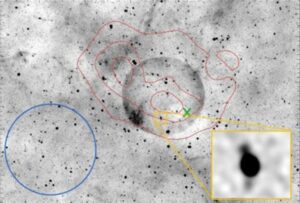A team of astronomers using the Australian Square Kilometre Array Pathfinder (ASKAP) radio telescope have detected a mysterious, almost perfectly spherical object in deep space.
Named Teleios, Greek for ‘perfection,’ the spherical object was invisible apart from the radio emissions it produces, and while similar to a supernova remnant (SNR) in many aspects, it also possesses features that evade immediate identification.
Mysterious Spherical Object Spotted by its Radio Emissions
In a pre-published study titled “The mystery of a perfectly shaped new Galactic supernova remnant,” the astronomy team behind the puzzling discovery details the aspects of the unusual spherical object that support classification as an SNR. They also highlight several unusual properties of the object that seem to contradict this conclusion, keeping the true identity of Teleios a mystery.
“We consider several different scenarios to explain Teleios’s unusual properties, all of which have their challenges,” they write.
For example, Teleios isn’t visible to the naked eye. Instead, the study authors note that it is “exclusively seen at radio-continuum frequencies.” This is consistent with known SNRs. The authors say the object “displays a remarkable circular symmetry in shape,” which would make it one of the most symmetrical galactic SNRs ever discovered. Still, the authors note that a supernova explosion in a pristine part of space could result in a relatively symmetrical sphere, meaning this condition does not rule out the SNR theory.
Conversely, Teleios is unusually dim for a Galactic SNR. According to the study authors, if it is a Galactic SNR, the mysterious spherical object has “one of the lowest surface brightnesses” ever discovered. Classifying Teleios as an SNR is also difficult because the object is missing something. Specifically, the team says their SNR models predict X-ray emissions, “which we do not see.”
“The lack of detectable X-ray emission is puzzling,” they write.

Three Possible Formation Scenarios
Although the team cannot definitively classify their mysterious object as an SNR, they propose three potential scenarios for Teleios’ origin.
In the first scenario, dubbed 1a, Teleios is an SNR approximately 7,175 light-years from Earth. The object would likely be around forty light-years in diameter at that distance. If correct, this scenario would make Teleios less than 1,000 years old.
In the second scenario, the team proposed an SNR 25,114 light years from Earth. An SNR at this galactic distance would span around 157 light years across to account for their readings. If correct, an SNR of this type would likely be over 10,000 years old.

The team also discussed a third scenario in which the SNR is 3,262 light years away. They note that this unlikely scenario would only match if Teleios were a Type Iax supernova, “which leaves behind a ‘zombie star’ remnant.”
All Examined Scenarios Have Their Challenges
The authors summarize the case for the different possible classification scenarios in the study’s conclusion. After examining their findings, they determined that classifying the spherical object as one particular type of SNR is not currently possible.
“We have made an exhaustive exploration of the possible evolutionary state of the SN based on its surface brightness, apparent size, and possible distances,” they write. “All possible scenarios have their challenges, especially considering the lack of X-ray emission that is expected to be detectable given our evolutionary modelling.”
While they deem the Type Ia scenario the most likely, they point out that “no direct evidence is available to definitively confirm any scenario.” Moving forward, the team says that “new sensitive and high-resolution observations of this object are needed” to resolve the mysterious object’s origin.
Christopher Plain is a Science Fiction and Fantasy novelist and Head Science Writer at The Debrief. Follow and connect with him on X, learn about his books at plainfiction.com, or email him directly at [email protected].
